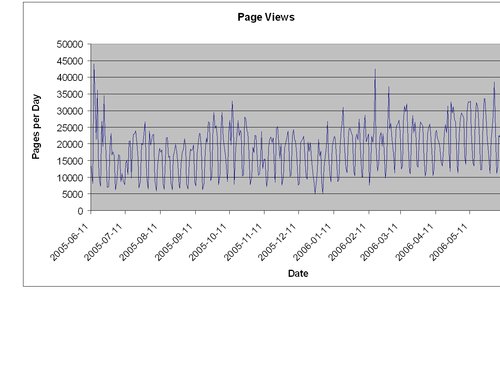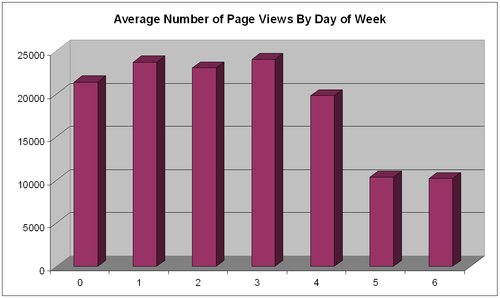Hack 20. Uncover Trends in Your Data


Statistics gathered daily could contain both daily cycles and weekly trends. This can lead to chaotic-looking graphs when activity is plotted day by day. You can improve your graphs easily using SQL.
Look at Figure 4-1, which shows a chart of the raw figures for the number of page views for a web site per day, over the course of one year. These figures come from Webalizer, the web log analysis program (http://www.mrunix.net/webalizer). It is difficult to see the trends because the weekly cycle overwhelms the daily detail, and obscures the long-term trend.
Figure 4-1. Page views per day over one year

To understand the data, you need to separate the effect of the weekly cycle from the table. You can see the weekly cycle by taking the average for Monday, the average for Tuesday, and so forth. In Figure 4-2, Monday to Sunday are numbered 0 to 6.
Figure 4-2. Average page views by day of week

Notice that the value of the Sunday column (column 6) is less than half the value of the midweek columns. This is helping to cause the zigzag pattern in the original graph. If you view the data averaged per week (see Figure 4-3) rather than per day, it is easier to see the long-term trend.
Figure 4-3. Smoothed data page views averaged for one week

|
Before you can isolate these trends, you must turn the dates into integers to more easily put them into the appropriate buckets. You can pick an arbitrary date and start counting from there. Table 4-2 shows some source data.
| whn | pages |
|---|---|
| 2005-06-11 | 13368 |
| 2005-06-12 | 8129 |
| 2005-06-13 | 44043 |
| ... |
In Table 4-3, I've chosen the first day of the millennium, Monday, January 1, 2001, as day zero. Every date must be converted into the number of days since then. The mechanism for converting to integers is different on different engines. In MySQL, you can create this view using the TO_DAYS function:
CREATE VIEW webalizer2 AS SELECT TO_DAYS(whn)-TO_DAYS(DATE '2001-01-01') whn, pages FROM webalizer;
| whn | pages |
|---|---|
| 1622 | 13368 |
| 1623 | 8129 |
| 1624 | 44043 |
| ... |
With dates now represented by integers, you can perform arithmetic on them. Taking the modulus 7 value gives you the day of the week. Because 2001-01-01 was a Monday, you will get 0 on every seventh day from then. Tuesday will give you 1, Wednesday 2, and so on, with Sunday having the value 6.
4.2.1. Modular Arithmetic
Look at the values for whn%7 and FLOOR(whn/7). You can see that day number 1,622 (counting from 2001-01-01) is day number 5 of week number 231:
mysql> SELECT whn, whn%7, whn/7, FLOOR(whn/7) -> FROM webalizer2; +------+-------+----------+--------------+ | whn | whn%7 | whn/7 | FLOOR(whn/7) | +------+-------+----------+--------------+ | 1622 | 5 | 231.7143 | 231 | | 1623 | 6 | 231.8571 | 231 | | 1624 | 0 | 232.0000 | 232 | | 1625 | 1 | 232.1429 | 232 | | 1626 | 2 | 232.2857 | 232 | | 1627 | 3 | 232.4286 | 232 | | 1628 | 4 | 232.5714 | 232 | | 1629 | 5 | 232.7143 | 232 | | 1630 | 6 | 232.8571 | 232 | | 1631 | 0 | 233.0000 | 233 | | 1632 | 1 | 233.1429 | 233 | ...
You need to GROUP BY the whn%7 column to see the weekly cycle and GROUP BY the FLOOR(whn/7) column to see the trend.
To look at the intra-week pattern shown back in Figure 4-2, you take the average with GROUP BY whn%7:
mysql> SELECT whn%7, AVG(pages) -> FROM webalizer2 GROUP BY whn%7; +-------+------------+ | whn%7 | AVG(pages) | +-------+------------+ | 0 | 21391.6731 | | 1 | 23695.1538 | | 2 | 23026.2308 | | 3 | 24002.8077 | | 4 | 19773.9808 | | 5 | 10353.5472 | | 6 | 10173.9423 | +-------+------------+
To smooth out the data over the whole year, as shown in Figure 4-3, you can divide by 7 and take the integer value using the FLOOR function:
mysql> SELECT FLOOR(whn/7), AVG(pages) -> FROM webalizer2 GROUP BY FLOOR(whn/7); +--------------+------------+ | FLOOR(whn/7) | AVG(pages) | +--------------+------------+ | 231 | 10748.5000 | | 232 | 23987.8571 | | 233 | 19321.1429 | | 234 | 15347.0000 | ...
The value for the first week is artificially lowby chance, it includes two on only two days, and they are on weekends. Something similar might happen at the end of the interval, so it is safest to exclude any week that does not have seven entries. The HAVING clause will take care of that:
mysql> SELECT FLOOR(whn/7), AVG(pages) -> FROM webalizer2 GROUP BY FLOOR(whn/7) -> HAVING COUNT(*)=7; +--------------+------------+ | FLOOR(whn/7) | AVG(pages) | +--------------+------------+ | 232 | 23987.8571 | | 233 | 19321.1429 | | 234 | 15347.0000 | ...
This will work fine with MySQL and PostgreSQL, but you need to make a few alterations for SQL Server, Access, and Oracle.
4.2.2. SQL Server
Here's how to create the view that represents dates as integers:
CREATE VIEW webalizer2 AS SELECT CONVERT(INT,whn-'2001-01-01') whn, pages FROM webalizer
The SELECT statements shown earlier will run unmodified.
4.2.3. Access
In Access, you can use Int(whn - #2001-01-01#) to extract the number of days since January 1, 2001:
SELECT Int(whn - #2001-01-01#), pages FROM webalizer
Also, MOD is an infix operator used in place of %:
SELECT whn MOD 7, AVG(pages) FROM webalizer2 GROUP BY whn MOD 7;
4.2.4. Oracle
Here's how to create the view that represents dates as integers:
CREATE VIEW webalizer2 AS SELECT whn-DATE '2001-01-01' whn, pages FROM webalizer;
In Oracle, the module function is MOD, so you'd need to use that rather than whn%7:
SELECT MOD(whn,7), AVG(pages) FROM webalizer2 GROUP BY MOD(whn,7);
SQL Fundamentals
- SQL Fundamentals
- Hack 1. Run SQL from the Command Line
- Hack 2. Connect to SQL from a Program
- Hack 3. Perform Conditional INSERTs
- Hack 4. UPDATE the Database
- Hack 5. Solve a Crossword Puzzle Using SQL
- Hack 6. Dont Perform the Same Calculation Over and Over
Joins, Unions, and Views
- Joins, Unions, and Views
- Hack 7. Modify a Schema Without Breaking Existing Queries
- Hack 8. Filter Rows and Columns
- Hack 9. Filter on Indexed Columns
- Hack 10. Convert Subqueries to JOINs
- Hack 11. Convert Aggregate Subqueries to JOINs
- Hack 12. Simplify Complicated Updates
- Hack 13. Choose the Right Join Style for Your Relationships
- Hack 14. Generate Combinations
Text Handling
- Text Handling
- Hack 15. Search for Keywords Without LIKE
- Hack 16. Search for a String Across Columns
- Hack 17. Solve Anagrams
- Hack 18. Sort Your Email
Date Handling
- Date Handling
- Hack 19. Convert Strings to Dates
- Hack 20. Uncover Trends in Your Data
- Hack 21. Report on Any Date Criteria
- Hack 22. Generate Quarterly Reports
- Hack 23. Second Tuesday of the Month
Number Crunching
- Number Crunching
- Hack 24. Multiply Across a Result Set
- Hack 25. Keep a Running Total
- Hack 26. Include the Rows Your JOIN Forgot
- Hack 27. Identify Overlapping Ranges
- Hack 28. Avoid Dividing by Zero
- Hack 29. Other Ways to COUNT
- Hack 30. Calculate the Maximum of Two Fields
- Hack 31. Disaggregate a COUNT
- Hack 32. Cope with Rounding Errors
- Hack 33. Get Values and Subtotals in One Shot
- Hack 34. Calculate the Median
- Hack 35. Tally Results into a Chart
- Hack 36. Calculate the Distance Between GPS Locations
- Hack 37. Reconcile Invoices and Remittances
- Hack 38. Find Transposition Errors
- Hack 39. Apply a Progressive Tax
- Hack 40. Calculate Rank
Online Applications
- Online Applications
- Hack 41. Copy Web Pages into a Table
- Hack 42. Present Data Graphically Using SVG
- Hack 43. Add Navigation Features to Web Applications
- Hack 44. Tunnel into MySQL from Microsoft Access
- Hack 45. Process Web Server Logs
- Hack 46. Store Images in a Database
- Hack 47. Exploit an SQL Injection Vulnerability
- Hack 48. Prevent an SQL Injection Attack
Organizing Data
- Organizing Data
- Hack 49. Keep Track of Infrequently Changing Values
- Hack 50. Combine Tables Containing Different Data
- Hack 51. Display Rows As Columns
- Hack 52. Display Columns As Rows
- Hack 53. Clean Inconsistent Records
- Hack 54. Denormalize Your Tables
- Hack 55. Import Someone Elses Data
- Hack 56. Play Matchmaker
- Hack 57. Generate Unique Sequential Numbers
Storing Small Amounts of Data
- Storing Small Amounts of Data
- Hack 58. Store Parameters in the Database
- Hack 59. Define Personalized Parameters
- Hack 60. Create a List of Personalized Parameters
- Hack 61. Set Security Based on Rows
- Hack 62. Issue Queries Without Using a Table
- Hack 63. Generate Rows Without Tables
Locking and Performance
- Locking and Performance
- Hack 64. Determine Your Isolation Level
- Hack 65. Use Pessimistic Locking
- Hack 66. Use Optimistic Locking
- Hack 67. Lock Implicitly Within Transactions
- Hack 68. Cope with Unexpected Redo
- Hack 69. Execute Functions in the Database
- Hack 70. Combine Your Queries
- Hack 71. Extract Lots of Rows
- Hack 72. Extract a Subset of the Results
- Hack 73. Mix File and Database Storage
- Hack 74. Compare and Synchronize Tables
- Hack 75. Minimize Bandwidth in One-to-Many Joins
- Hack 76. Compress to Avoid LOBs
Reporting
- Reporting
- Hack 77. Fill in Missing Values in a Pivot Table
- Hack 78. Break It Down by Range
- Hack 79. Identify Updates Uniquely
- Hack 80. Play Six Degrees of Kevin Bacon
- Hack 81. Build Decision Tables
- Hack 82. Generate Sequential or Missing Data
- Hack 83. Find the Top n in Each Group
- Hack 84. Store Comma-Delimited Lists in a Column
- Hack 85. Traverse a Simple Tree
- Hack 86. Set Up Queuing in the Database
- Hack 87. Generate a Calendar
- Hack 88. Test Two Values from a Subquery
- Hack 89. Choose Any Three of Five
Users and Administration
- Users and Administration
- Hack 90. Implement Application-Level Accounts
- Hack 91. Export and Import Table Definitions
- Hack 92. Deploy Applications
- Hack 93. Auto-Create Database Users
- Hack 94. Create Users and Administrators
- Hack 95. Issue Automatic Updates
- Hack 96. Create an Audit Trail
Wider Access
- Wider Access
- Sharing Data Across the Internet
- Hack 97. Allow an Anonymous Account
- Hack 98. Find and Stop Long-Running Queries
- Hack 99. Dont Run Out of Disk Space
- Hack 100. Run SQL from a Web Page
Index
EAN: 2147483647
Pages: 147
- Challenging the Unpredictable: Changeable Order Management Systems
- Enterprise Application Integration: New Solutions for a Solved Problem or a Challenging Research Field?
- Distributed Data Warehouse for Geo-spatial Services
- Healthcare Information: From Administrative to Practice Databases
- A Hybrid Clustering Technique to Improve Patient Data Quality

